Spatiotemporal Variation and Climate Influence Factors of Vegetation Ecological Quality in the Sanjiangyuan National Park
Abstract
:1. Introduction
2. Materials and Methods
2.1. Study Area
2.2. Data Collection and Processing
2.3. Methods
2.3.1. Framework of NPP Assessment
2.3.2. Trends and Regression Analysis
2.3.3. Trends and Relationship Classification
3. Results
3.1. Spatial Patterns of NDVI and NPP
3.2. Regional Scale Changes in NDVI and NPP
3.3. Pixel Scale Changes in NDVI and NPP
3.4. Changes in Annual Precipitation and Average Temperature
3.5. Response of Vegetation to Climatic Conditions at Regional Scale
3.6. Response of Vegetation to Climatic Conditions at Pixel Scale
4. Discussions
4.1. The Spatiotemporal Variation of Vegetation NDVI and NPP
4.2. The Response of Vegetation to Annual Precipitation and Annual Average Temperature
4.3. The Response of Vegetation to Precipitation and Average Temperature of Different Months
5. Conclusions
- (1)
- There was a significant spatial heterogeneity of NDVI and NPP in the Sanjiangyuan National Park. Generally, the NDVI and NPP values were high in the southeast and low in the northwest. The Yangtze River headwater region had the lowest value of NDVI, mainly in the range of 0 to 0.3, and of NPP, mainly in the range of 0 to 100 gC/m2; the Lancang River had the highest value of NDVI, mainly in the range of 0.4 to 0.8, and of NPP, mainly in the range of 100 to 250 gC/m2. As for the five vegetation categories, the coniferous forests had the highest values of NDVI and NPP, followed by the shrub and meadow, while the prairie had the lowest values of NDVI and NPP.
- (2)
- There were no obvious positive or negative trends in the annual NDVI and NPP time series from 2000–2016. However, a general significant increasing trend was found during the 2000–2014 period with an average annual growth rate of 0.0022/a (p < 0.05) and 1.3824 gC/m2/a (p < 0.05). From 2000–2016, approximately 23.46% of the area showed a significant positive trend of NDVI that was mainly distributed in the prairie areas in the midlands and the north of the Yangtze River headwater region and in the midlands and the north of the Yellow River headwater region. It was determined that 24.32% of the NPP time series increased significantly, mainly distributed in the midlands and north of the Yangtze River headwater region and in the midlands and east of the Yellow River headwater region.
- (3)
- The vegetation growth in the Sanjiangyuan National Park was regulated using both water and heat conditions. The NDVI–annual average temperature correlation was stronger than NDVI–annual average temperature correlation in the three headwater regions and for all vegetation types. Increased precipitation and temperature could enhance photosynthesis and respiration for plant growth. Additionally, average temperature was an influencing factor of the change in NPP in the area, with a positive correlation with all vegetation types. However, there was no significant correlation between NPP and annual precipitation among all vegetation types, but weak positive influences on the NPP were detected in the prairie and meadow based on the unilateral significance test.
- (4)
- The response of vegetation to climate condition showed great spatial and temporal differences. The NDVI was profoundly affected by precipitation during the growing season for the study area, and was also influenced by the average temperature in May for the Yellow River headwater region, September for the Yangtze River headwater region, and July for the Lancang River headwater region. The NPP was significantly affected by temperature during the growing season for the study area. In addition, the NPP was regulated by the precipitation in July for the Yellow River and Yangtze River headwater regions.
Author Contributions
Funding
Conflicts of Interest
References
- Running, S.W. A Measurable Planetary Boundary for the Biosphere. Science 2012, 337, 1458–1459. [Google Scholar] [CrossRef] [PubMed] [Green Version]
- Piao, S.; Wang, X.; Park, T.; Chen, C.; Lian, X.; He, Y.; Bjerke, J.W.; Chen, A.; Ciais, P.; Tømmervik, H.; et al. Characteristics, drivers and feedbacks of global greening. Nat. Rev. Earth Environ. 2019, 1, 14–27. [Google Scholar] [CrossRef]
- Chu, C.; Bartlett, M.; Wang, Y.; He, F.; Weiner, J.; Chave, J.; Sack, L. Does climate directly influence NPP globally? Glob. Chang. Boil. 2015, 22, 12–24. [Google Scholar] [CrossRef] [PubMed]
- Field, C.B.; Randerson, J.T.; Malmstrom, C.M. Global net primary production: Combining ecology and remote sensing. Remote. Sens. Environ. 1995, 51, 74–88. [Google Scholar] [CrossRef] [Green Version]
- Wang, X.; Tan, K.; Chen, B.; Du, P. Assessing the Spatiotemporal Variation and Impact Factors of Net Primary Productivity in China. Sci. Rep. 2017, 7, 44415. [Google Scholar] [CrossRef] [Green Version]
- Defries, R.S.; Townshend, J.R.G. NDVI-derived land cover classifications at a global scale. Int. J. Remote Sens. 1994, 15, 3567–3586. [Google Scholar] [CrossRef]
- Piao, S.L.; Fang, J.Y.; He, J.S. Variations in vegetation net primary production in the Qinghai–Xiang Plateau, China, from 1982 to 1999. Clim. Chang. 2006, 74, 253–267. [Google Scholar] [CrossRef]
- Yang, Y.; Guan, H.; Shen, M.; Liang, W.; Jiang, L. Changes in autumn vegetation dormancy onset date and the climate controls across temperate ecosystems in China from 1982 to 2010. Glob. Chang. Biol. 2014, 21, 652–665. [Google Scholar] [CrossRef]
- El Masri, B.; Barman, R.; Meiyappan, P.; Song, Y.; Liang, M.; Jain, A. Carbon dynamics in the Amazonian Basin: Integration of eddy covariance and ecophysiological data with a land surface model. Agric. For. Meteorol. 2013, 182, 156–167. [Google Scholar] [CrossRef]
- Hemming, D.; Betts, R.; Collins, M. Sensitivity and uncertainty of modelled terrestrial net primary productivity to doubled CO2 and associated climate change for a relatively large perturbed physics ensemble. Agric. For. Meteorol. 2013, 170, 79–88. [Google Scholar] [CrossRef]
- Piao, S.; Fang, J.; Zhou, L.; Zhu, B.; Tan, K.; Tao, S. Changes in vegetation net primary productivity from 1982 to 1999 in China. Glob. Biogeochem. Cycles 2005, 19. [Google Scholar] [CrossRef] [Green Version]
- Zhao, M.; Running, S.W. Drought-Induced Reduction in Global Terrestrial Net Primary Production from 2000 Through 2009. Science 2010, 329, 940–943. [Google Scholar] [CrossRef] [PubMed] [Green Version]
- Liu, Y.; Ju, W.; He, H.; Wang, S.; Sun, R.; Zhang, Y. Changes of net primary productivity in China during recent 11 years detected using an ecological model driven by MODIS data. Front. Earth Sci. 2012, 7, 112–127. [Google Scholar] [CrossRef]
- Sun, Q.; Li, B.; Zhou, C.; Li, F.; Zhang, Z.; Ding, L.; Zhang, T.; Xu, L. A systematic review of research studies on the estimation of net primary productivity in the Three-River Headwater Region, China. J. Geogr. Sci. 2016, 27, 161–182. [Google Scholar] [CrossRef]
- Fang, J.Y.; Piao, S.L.; He, J.S.; Field, C.B.; Pan, Y.; Guo, Q.; Zhou, L.; Tao, S. Increasing net primary production in China from 1982 to 1999. Front. Ecol. Environ. 2003, 1, 293–297. [Google Scholar] [CrossRef]
- Shao, Q.; Fan, J.; Liu, J.; Huang, L.; Cao, W.; Liu, L. Target-based Assessment on Effects of First-stage Ecological Conservation and Restoration Project in Three-river Source Region, China and Policy Recommendations. Chinese Sci. Bull. 2017, 32, 35–44. (In Chinese) [Google Scholar]
- Li, H.; Liu, G.; Fu, B. Response of vegetation to climate change and human activity based on NDVI in the Three-River Headwaters region. Acta Ecol. Sin. 2011, 31, 5495–5504. (In Chinese) [Google Scholar]
- Hou, X.Y. Vegetation of China; People’s Education Press: Beijing, China, 1960. (In Chinese) [Google Scholar]
- Wang, C.W. The Forests of China with a Survey of Grassland and Desert Vegetation; Harvard University: Cambridge, MA, USA, 1961. [Google Scholar]
- Chang, D.H.S. The Vegetation Zonation of the Tibetan Plateau. Mt. Res. Dev. 1981, 1, 29. [Google Scholar] [CrossRef]
- Chen, L.Z.; Sun, H.; Guo, K. Flora and Vegetation Geography of China; Science Press: Beijing, China, 2014. (In Chinese) [Google Scholar]
- MacKinnon, J.; Sha, M.; Cheung, C.; Carey, G.; Xiang, Z.; Melville, D. A Biodiversity Review of China; Worldwide Fund for Nature (WWF) International: Hong Kong, China, 1996. [Google Scholar]
- Schaller, G.B. Wildlife of the Tibetan Steppe; The University of Chicago Press: Chicago, IL, USA, 1998. [Google Scholar]
- Brown, M.E.; Pinzon, J.; Didan, K.; Morisette, J.; Tucker, C. Evaluation of the consistency of long-term NDVI time series derived from AVHRR, SPOT-vegetation, SeaWiFS, MODIS, and Landsat ETM+ sensors. IEEE Trans. Geosci. Remote Sens. 2006, 44, 1787–1793. [Google Scholar] [CrossRef]
- Chen, P.-Y.; Fedosejevs, G.; Tiscareño-López, M.; Arnold, J.G. Assessment of MODIS-EVI, MODIS-NDVI and VEGETATION-NDVI Composite Data Using Agricultural Measurements: An Example at Corn Fields in Western Mexico. Environ. Monit. Assess. 2005, 119, 69–82. [Google Scholar] [CrossRef]
- Fensholt, R.; Proud, S.R. Evaluation of Earth Observation based global long term vegetation trends—Comparing GIMMS and MODIS global NDVI time series. Remote Sens. Environ. 2012, 119, 131–147. [Google Scholar] [CrossRef]
- Shen, X.; An, R.; Feng, L.; Ye, N.; Zhu, L.; Li, M. Vegetation changes in the Three-River Headwaters Region of the Tibetan Plateau of China. Ecol. Indic. 2018, 93, 804–812. [Google Scholar] [CrossRef]
- Vermote, E.F.; Kotchenova, S.Y.; Ray, J.P. MODIS Surface Reflectance User’s Guide. MODIS Land Surf. Reflect. Sci. Comput. Facil. 2011, 1. [Google Scholar]
- Holben, B.N. Characteristics of maximum-value composite images from temporal AVHRR data. Int. J. Remote Sens. 1986, 7, 1417–1434. [Google Scholar] [CrossRef]
- Basconcillo, J.Q.; Duran, G.A.W.; Francisco, A.A.; Abastillas, R.G.; Hilario, F.D.; Juanillo, E.L.; Maratas, S.L.A. Evaluation of Spatial Interpolation Techniques for Operational Climate Monitoring in the Philippines. SOLA Sci. Online Lett. Atmosp. 2017, 13, 114–119. [Google Scholar] [CrossRef] [Green Version]
- Potter, C.; Randerson, J.T.; Field, C.B.; Matson, P.A.; Vitousek, P.M.; Mooney, H.A.; Klooster, S.A. Terrestrial ecosystem production: A process model based on global satellite and surface data. Glob. Biogeochem. Cycles 1993, 7, 811–841. [Google Scholar] [CrossRef]
- Bishop, J.K.B.; Rossow, W.B. Spatial and temporal variability of global surface solar irradiance. J. Geophys. Res. Space Phys. 1991, 96, 16839. [Google Scholar] [CrossRef]
- McCree, K.J. Photosynthetically Active Radiation. In Physiological Plant Ecology I; Springer Science and Business Media LLC: Berlin/Heidelberg, Germany, 1981; Volume 12A, pp. 41–55. [Google Scholar]
- Zhang, Y.; Qi, W.; Zhou, C.; Ding, M.; Liu, L.; Gao, J.; Bai, W.; Wang, Z.; Zheng, D. Spatial and temporal variability in the net primary production of alpine grassland on the Tibetan Plateau since 1982. J. Geogr. Sci. 2014, 24, 269–287. [Google Scholar] [CrossRef]
- Cai, H.; Yang, X.; Xu, X. Human-induced grassland degradation/restoration in the central Tibetan Plateau: The effects of ecological protection and restoration projects. Ecol. Eng. 2015, 83, 112–119. [Google Scholar] [CrossRef]
- Xu, J.X.; Fang, S.B.; Zhang, T.B.; Zhu, Y.C.; Wu, D.; Yi, G.H. NDVI changes and its correlation with climate factors of the Three River -Headwater region in growing seasons during 2000—2016. Rem. Sens. Land Res. 2020, 32, 237–246. [Google Scholar]
- Chavez, F.P.; Messié, M.; Pennington, J.T. Marine Primary Production in Relation to Climate Variability and Change. Annu. Rev. Mar. Sci. 2011, 3, 227–260. [Google Scholar] [CrossRef] [PubMed] [Green Version]
- Fensholt, R.; Langanke, T.; Rasmussen, K.; Reenberg, A.; Prince, S.D.; Tucker, C.; Scholes, M.C.; Le, Q.B.; Bondeau, A.; Eastman, R.; et al. Greenness in semi-arid areas across the globe 1981–2007—An Earth Observing Satellite based analysis of trends and drivers. Remote Sens. Environ. 2012, 121, 144–158. [Google Scholar] [CrossRef]
- Tan, K.; Ciais, P.; Piao, S.; Wu, X.; Tang, Y.; Vuichard, N.; Liang, S.; Fang, J. Application of the ORCHIDEE global vegetation model to evaluate biomass and soil carbon stocks of Qinghai-Tibetan grasslands. Glob. Biogeochem. Cycles 2010, 24. [Google Scholar] [CrossRef]
- Chuai, X.W.; Huang, X.J.; Wang, W.J.; Bao, G. NDVI, temperature and precipitation changes and their relationships with different vegetation types during 1998–2007 in Inner Mongolia, China. Int. J. Clim. 2012, 33, 1696–1706. [Google Scholar] [CrossRef]
- Zheng, L.; Xu, J.; Tan, Z.; Xu, L.; Wang, X. Spatial Distribution of Soil Organic Matter Related to Microtopography and NDVI Changes in Poyang Lake, China. Wetlands 2019, 39, 789–801. [Google Scholar] [CrossRef]
- Ze, H.; Wei, S.; Xiangzheng, D.; Xu, X. Grassland ecosystem responses to climate change and human activities within the Three-River Headwaters region of China. Sci. Rep. 2018, 8, 9079. [Google Scholar]
- Zheng, Y.; Han, J.; Huang, Y.; Fassnacht, S.R.; Xie, S.; Lv, E.; Chen, M. Vegetation response to climate conditions based on NDVI simulations using stepwise cluster analysis for the Three-River Headwaters region of China. Ecol. Indic. 2018, 92, 18–29. [Google Scholar] [CrossRef]
- Cao, R.; Jiang, W.G.; Yuan, L.H.; Wang, W.; Lv, Z.; Chen, Z. Inter-annual variations in vegetation and their response to climatic factors in the upper catchments of the Yellow River from 2000 to 2010. J. Geogr. Sci. 2014, 24, 963–979. [Google Scholar] [CrossRef] [Green Version]
- Jiang, C.; Zhang, L. Climate Change and Its Impact on the Eco-Environment of the Three-Rivers Headwater Region on the Tibetan Plateau, China. Int. J. Environ. Res. Public Health 2015, 12, 12057–12081. [Google Scholar] [CrossRef] [Green Version]
- Lan, Y.; Zhao, G.; Zhang, Y.; Wen, J.; Hu, X.; Liu, J.; Gu, M.; Chang, J.; Ma, J. Response of runoff in the headwater region of the Yellow River to climate change and its sensitivity analysis. J. Geogr. Sci. 2010, 20, 848–860. [Google Scholar] [CrossRef]
- Nemani, R.; Keeling, C.D.; Hashimoto, H.; Jolly, W.M.; Piper, S.C.; Tucker, C.J.; Myneni, R.B.; Running, S.W. Climate-Driven Increases in Global Terrestrial Net Primary Production from 1982 to 1999. Science 2003, 300, 1560–1563. [Google Scholar] [CrossRef] [PubMed] [Green Version]
- Zhao, X.; Tan, K.; Zhao, S.; Fang, J. Changing climate affects vegetation growth in the arid region of the northwest China. J. Arid. Environ. 2011, 75, 946–952. [Google Scholar] [CrossRef]





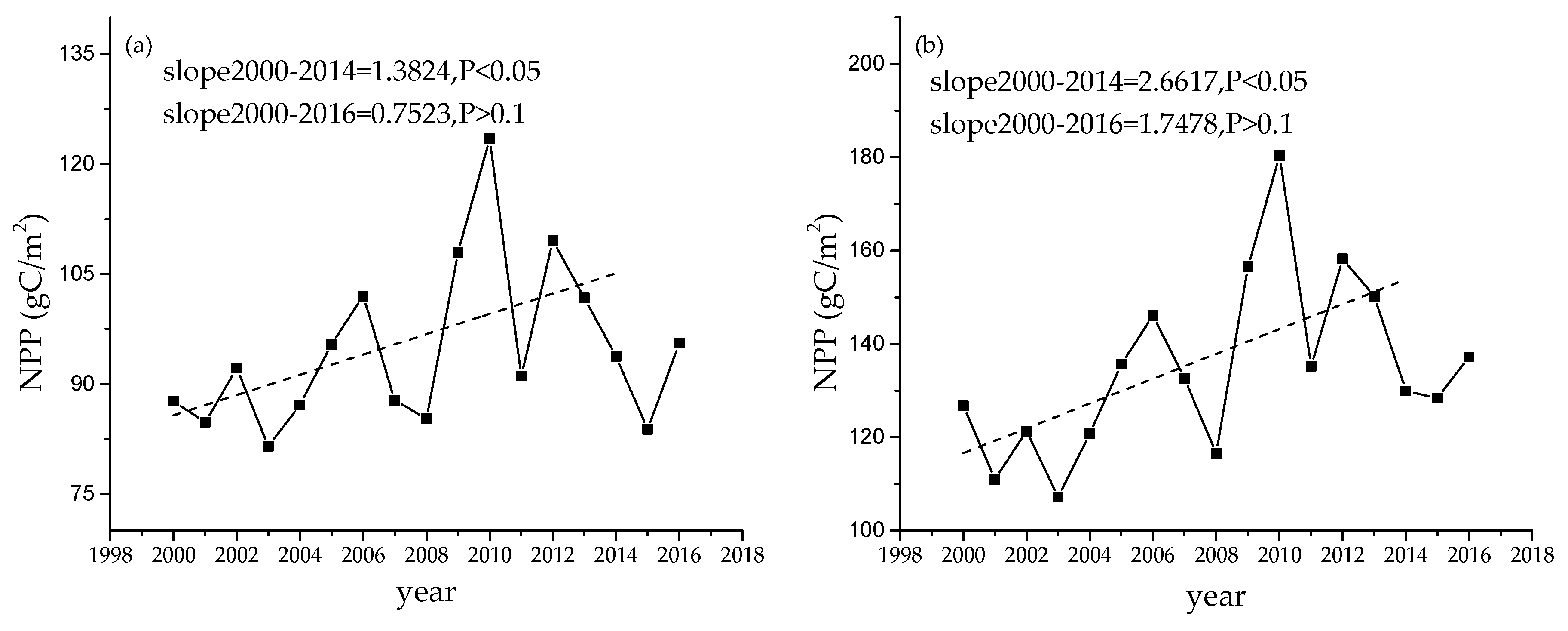
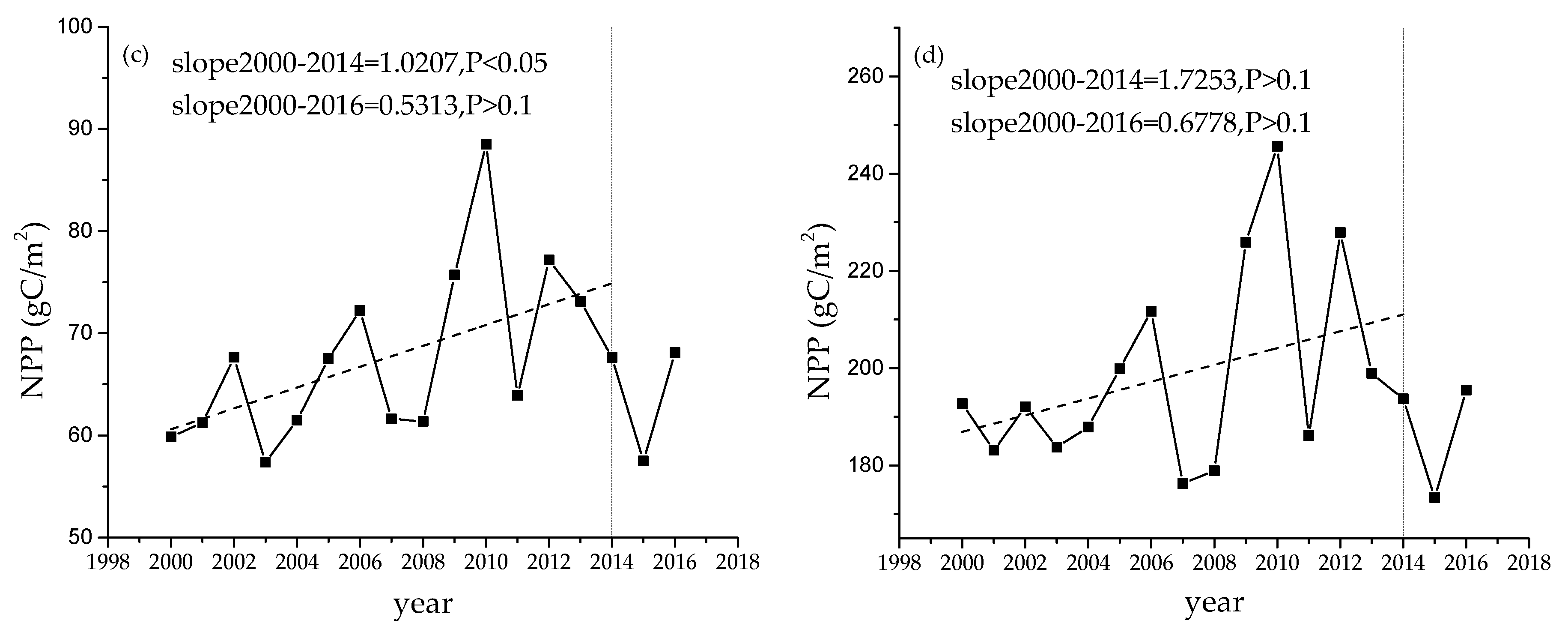


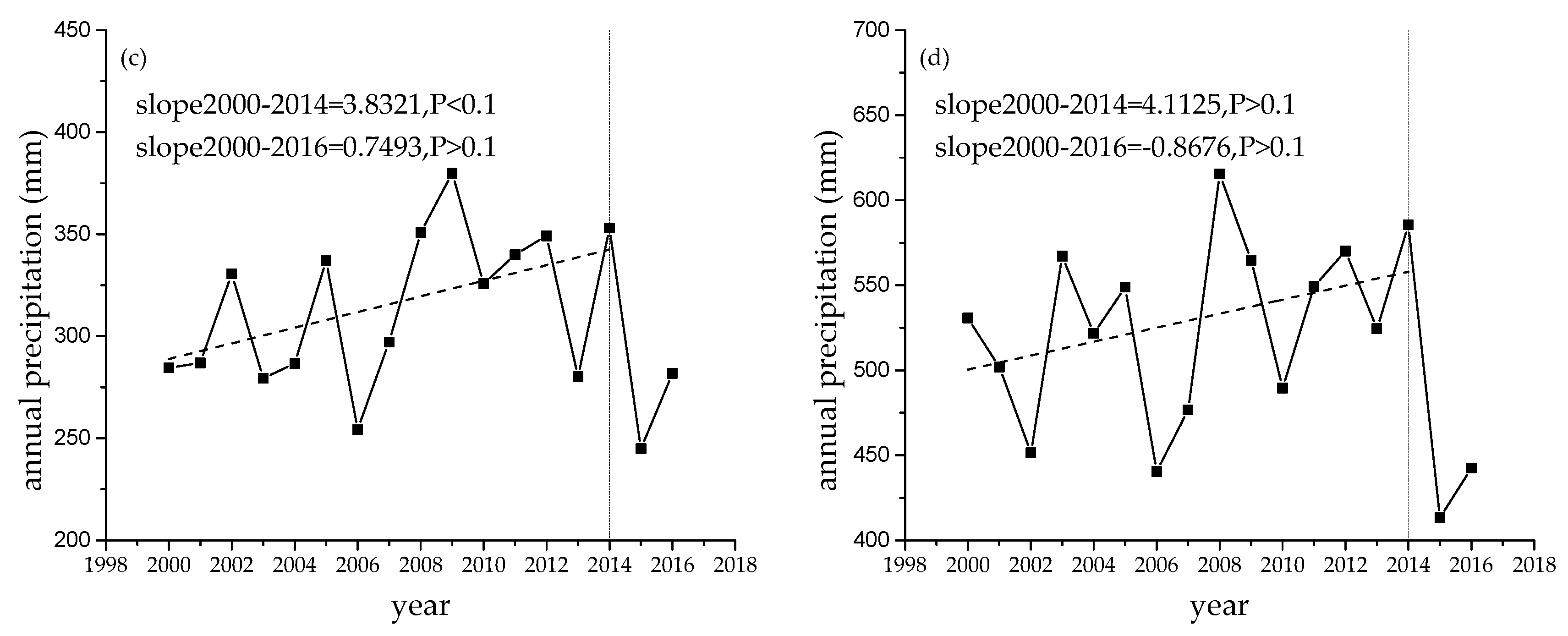


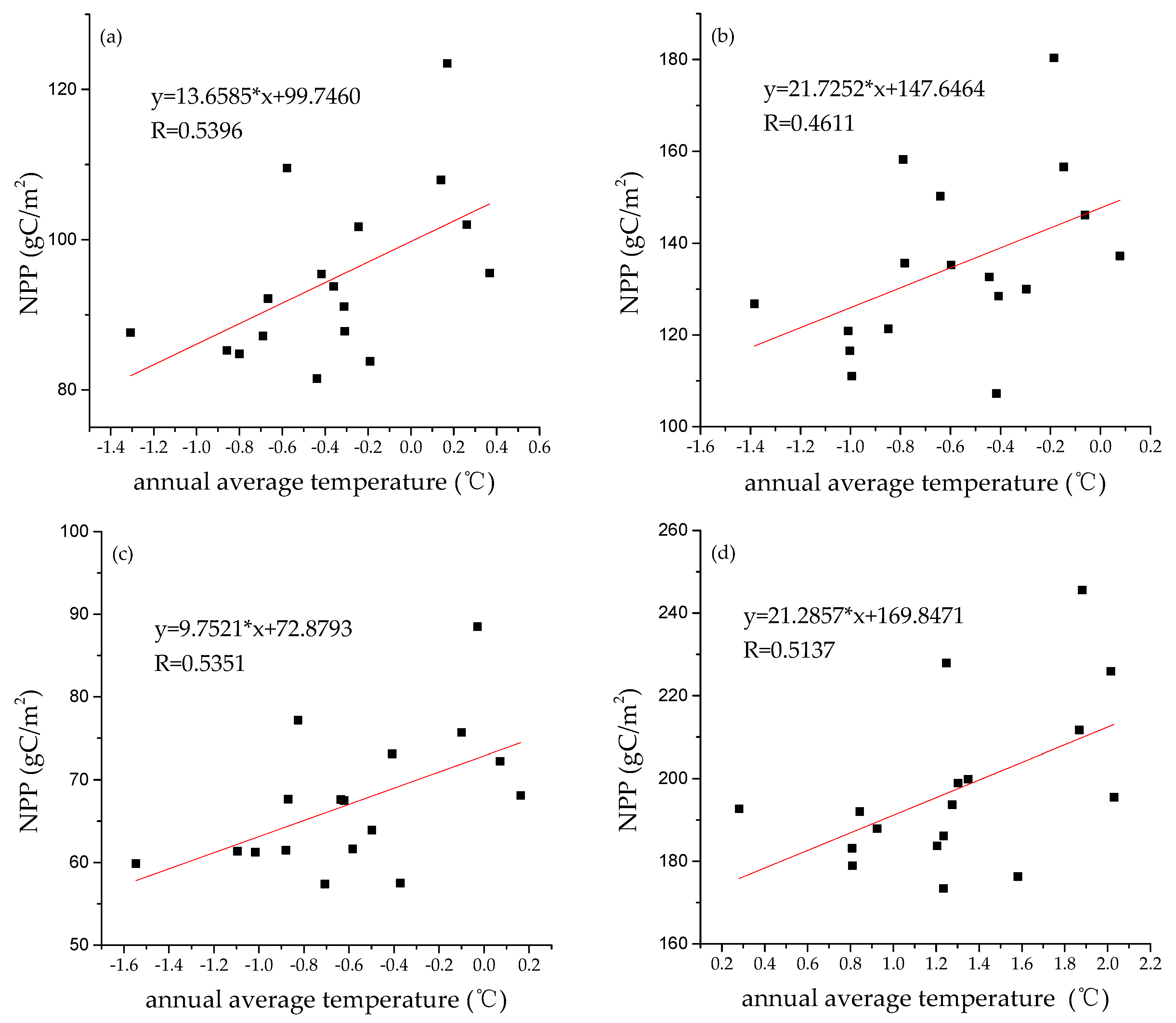
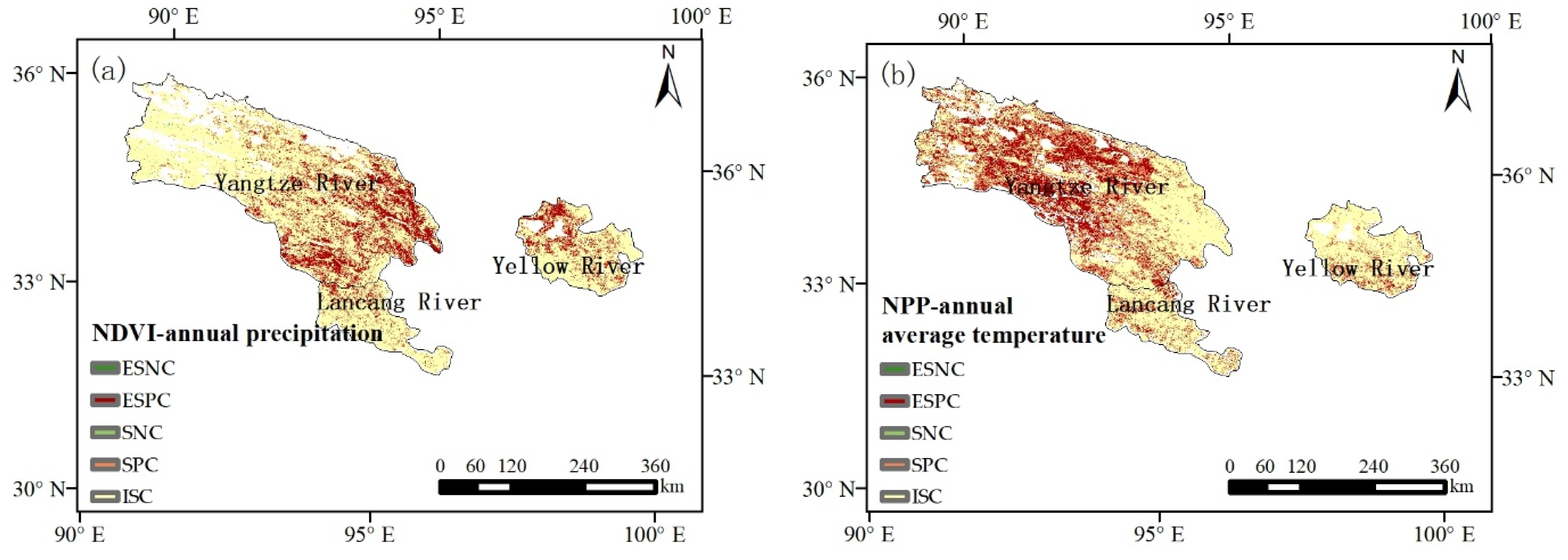
| Vegetation Type Slope | NDVI | NPP | ||
|---|---|---|---|---|
| 2000–2014 | 2000–2016 | 2000–2014 | 2000–2016 | |
| Coniferous forest | 0.0025 * | 0.0011 | 2.35 * | 0.72 |
| Shrub | 0.0028 ** | 0.0012 | 2.9 ** | 1.60 |
| Prairie | 0.0019 *** | 0.0011 ** | 0.65 ** | 0.4 * |
| Meadow | 0.0026 ** | 0.0009 | 2.03 ** | 1.05 |
| Alpine vegetation | 0.0018 ** | 0.0009 | 0.83 * | 0.55 |
| Region | ESI | SI | IS | SD | ESD |
|---|---|---|---|---|---|
| Yellow River | 6.27% | 11.40% | 81.28% | 0.73% | 0.32% |
| Lancang River | 0.36% | 1.75% | 94.73% | 2.49% | 0.68% |
| Yangtze River | 15.20% | 13.58% | 70.08% | 0.78% | 0.36% |
| Sanjiangyuan | 11.78% | 11.68% | 75.15% | 1.00% | 0.39% |
| Region | ESI | SI | IS | SD | ESD |
|---|---|---|---|---|---|
| Yellow River | 11.04% | 23.24% | 65.61% | 0.07% | 0.03% |
| Lancang River | 0.43% | 2.35% | 97.07% | 0.12% | 0.02% |
| Yangtze River | 9.92% | 15.74% | 73.98% | 0.21% | 0.14% |
| Sanjiangyuan | 8.97% | 15.35% | 75.40% | 0.18% | 0.11% |
| Region | NDVI | NPP | ||
|---|---|---|---|---|
| Annual Precipitation | Annual Average Temperature | Annual Precipitation | Annual Average Temperature | |
| Yellow River | 0.6281 *** | 0.2554 | 0.4828 ** | 0.4610 * |
| Lancang River | 0.5210 ** | 0.1930 | 0.0802 | 0.5137 ** |
| Yangtze River | 0.6849 *** | 0.3569 | 0.3925 | 0.5350 ** |
| Sanjiangyuan | 0.6729 *** | 0.3392 | 0.3526 | 0.5396 ** |
| Vegetation Types | NDVI | NPP | ||
|---|---|---|---|---|
| Annual Precipitation | Annual Average Temperature | Annual Precipitation | Annual Average Temperature | |
| Coniferous forest | 0.4778 * | 0.3262 | 0.1353 | 0.4571 * |
| Shrub | 0.5848 *** | 0.4221 * | 0.1977 | 0.5486 ** |
| Prairie | 0.6105 *** | 0.4671 * | 0.3424 | 0.5935 ** |
| Meadow | 0.6930 *** | 0.2987 | 0.3722 | 0.5146 ** |
| Alpine vegetation | 0.5564 ** | 0.4417 * | 0.1509 | 0.643 *** |
| Region | ESPC | SPC | ISC | SNC | ESNC |
|---|---|---|---|---|---|
| Yellow River | 13.17% | 20.06% | 66.63% | 0.10% | 0.00% |
| Lancang River | 5.49% | 15.45% | 78.86% | 0.18% | 0.01% |
| Yangtze River | 15.32% | 18.59% | 65.80% | 0.23% | 0.06% |
| Sanjiangyuan | 13.69% | 18.42% | 67.64% | 0.20% | 0.05% |
| Region | ESPC | SPC | ISC | SNC | ESNC |
|---|---|---|---|---|---|
| Yellow River | 3.34% | 18.77% | 77.88% | 0.01% | 0.00% |
| Lancang River | 8.38% | 21.15% | 70.45% | 0.02% | 0.01% |
| Yangtze River | 24.56% | 29.60% | 45.82% | 0.01% | 0.00% |
| Sanjiangyuan | 19.23% | 26.86% | 53.90% | 0.01% | 0.00% |
© 2020 by the authors. Licensee MDPI, Basel, Switzerland. This article is an open access article distributed under the terms and conditions of the Creative Commons Attribution (CC BY) license (http://creativecommons.org/licenses/by/4.0/).
Share and Cite
Sun, Q.; Liu, W.; Gao, Y.; Li, J.; Yang, C. Spatiotemporal Variation and Climate Influence Factors of Vegetation Ecological Quality in the Sanjiangyuan National Park. Sustainability 2020, 12, 6634. https://doi.org/10.3390/su12166634
Sun Q, Liu W, Gao Y, Li J, Yang C. Spatiotemporal Variation and Climate Influence Factors of Vegetation Ecological Quality in the Sanjiangyuan National Park. Sustainability. 2020; 12(16):6634. https://doi.org/10.3390/su12166634
Chicago/Turabian StyleSun, Qianying, Weiwei Liu, Yanni Gao, Junsheng Li, and Chunyan Yang. 2020. "Spatiotemporal Variation and Climate Influence Factors of Vegetation Ecological Quality in the Sanjiangyuan National Park" Sustainability 12, no. 16: 6634. https://doi.org/10.3390/su12166634




